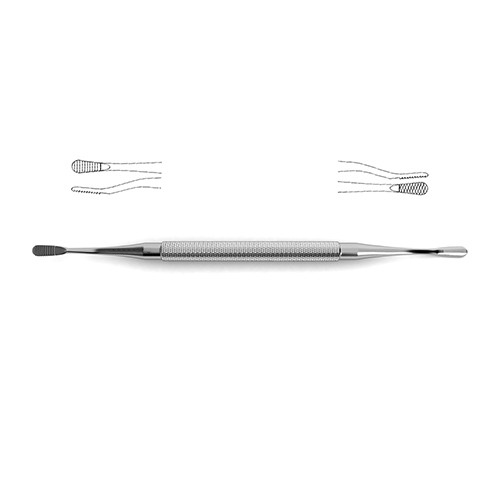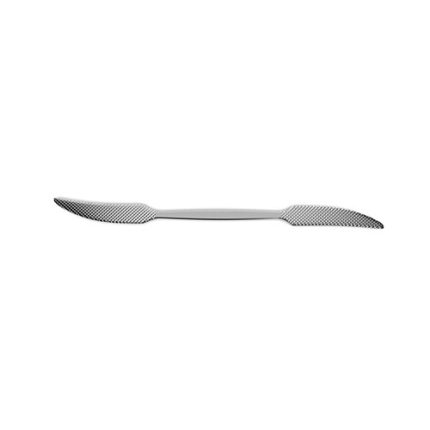| Name | Bone File #12A |
| Lead Time | 0-3 days |
| Specialty | Neuro, Ortho & Spine-Rasps & Files |
| Material Finish | Stainless Steel |
| Grade | Premium Operating Room |
| Units of Measurement | Each |
| Manufacturer | King Plus Surgical Industry |
| Sterility | Non-Sterile |
| Usage | Reusable |
Bone File #12A
double-ended, one end plain, other end cross serrated, 5.0 mm wide ends, 7″ (17.5 cm) Bone File #12A is a highly versatile file that can be used in surgical procedures that require manipulation of bone. It is ideally suit for some forms of bone reshaping such as a jagged edge that could endanger the tissue areas around it. In procedures such as craniotomies in which delicate brain tissue is being handled this file aids in keeping the bony area around smooth and free of harmful points. Additionally this instrument is double ended with one end plain and the other cross serrated making it a multi functional file.
SKU:
KPS-01-1231
Category: Rasps & Files
Description
Reviews (0)
Be the first to review “Bone File #12A” Cancel reply
Shipping & Delivery
Related products
Bone File #10
double-ended, plain serrations, 5.0 mm wide ends, 7" (17.5 cm) Bone File #10 is a general purpose instrument useful in surgical procedures that require manipulation of bone. This file is double ended making it quick and easy to switch to another unused file without having to switch instrumentation. Each end features plain serrations and is 5.0 mm wide. Additionally this instrument features a slightly textured handle surface that reduces slippage making this instrument ideally suited for a variety of precise neurosurgical procedures.
Nail & Bone Rasp
double ended, backwards cutting, 6-3/4" (17.1 cm) Nail and Bone Rasp is ideal for a number of different neurosurgical orthopedic type surgeries. This rasp is double ended making it a two in one and can quickly switch between thw two heads. It has the ability to be backwards cutting. This instrument features serrations that allow either end to be used to whittle down or smooth roughened surfaces. In craniotomies or spinal surgeries such jagged edges can cause tearing on delicate tissue such as brain tissue or individual nerves and vasculature.
Bone File – Double-Ended
double-ended, cross-cut, 7" (18.0 cm) Bone File is a highly versatile instrument that can be used in a vast array of surgical procedures. This file is double ended and is cross cut. The small paddle style blades allow it to be used near delicate tissue areas as are common in neurosurgical procedures and not cause trauma or injury by puncture wound. Additionally use of this file on jagged bone breaks or cuts or even on rough hard surfaces aids in the protected of neurovascular bundles and other tissue layers that are mobilized during surgery that can easily be torn or injured.
Bone & Skin Rasp
5-1/8" (13.0 cm) Bone and Skin Rasp is a unique instrument ideal for use in surgical procedures that require manipulation of bone and other hard tissue surfaces. This rasp features a long, slim handle from which extends a spatula like protrusion that has an alternating pattern of dots on it that makes this surface suited for slight filing. Not as abrasive as a file this rasp can be used for the mild reshaping of bone or more delicate semi-solid tissue layers such as bone to prevent sharp edges from causing damage to other adjacent tissue or vasculature.
Putti Bone Rasp – Round Blades
round blades, double-ended, 1 10.0 mm round blade tapers to 4.0 mm & 1 15.0 mm half-round blade tapers to 5.0 mm, 12" (30.5 cm) Putti Bone Rasp is an instrument ideally suited for use in surgeries that require handling and particularly mild reshaping of bone such as in neurosurgical or orthopedic surgeries. . This instrument is double ended and features one round blade and another half round. The unique design of this rasp is in the leap shaped silhouette that tapers from 11.0 mm to 4.0 mm for the round blade and from 15.0 mm to 5.0 for the half round that allows it to be fit into slim and narrow spaces and effectively whittle down bone or hard tissue from any angle.
Bone File #92A
single-ended, 2.0 mm wide, file outside, backward cutting, angled w/ serrations, 6" (15.0 cm) Bone File is a highly versatile instrument that can be used in almost any neurosurgical orthopedic procedures. Ranging from craniotomies to spinal surgery this file can be used to file down any types of bone. This can be useful in smoothing down rough edges to prevent catching or tearing of delicate tissues or vasculature during surgical intervention. This instrument is single-ended with the file outside and is angled with serrations and can be used in backward cutting.
Putti Bone Rasp – Flat Blades
flat blades, double-ended flat blades, 18.0 mm width tapers to 4.0 mm, 1 end curved up, 1 end curved sideways, 10-1/2" (26.5 cm)Putti Bone Rasp is an instrument ideally suited for use in surgeries that require handling and particularly mild reshaping of bone such as in neurosurgical or orthopedic surgeries. . This instrument is double ended and features two flat blades. The unique design of this rasp is in the leap shaped silhouette that tapers from 18.00 mm to 4.0 mm that allows it to be fit into slim and narrow spaces and effectively whittle down bone or hard tissue from any angle.
Bone File #33
double-ended, plain serrations, 6.0 mm & 5.0 mm wide ends, 7" (17.5 cm) Bone File #33 is ideally suit for use in neurosurgical and orthopedic surgeries that require manipulation of bone in and around delicate tissue structures. This type of instrument can be useful in filing down the skull in procedures like craniotomies or in reshaping the vertebral arch during laminectomies or hemi-laminectomies. This gives added protection to the brain tissue or neurovascular bundles that can pass over these cut surfaces that may be jagged and could cause additionally injury or trauma. Additionally this file is double ended with plain serrations and features a 6.0 mm and 5.0 mm wide ends.











Reviews
There are no reviews yet.